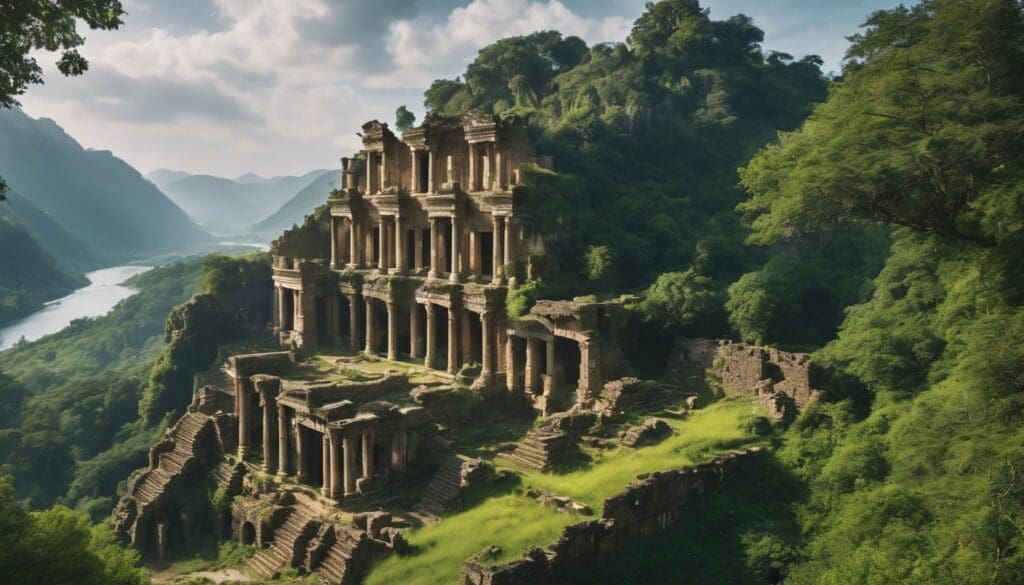We all feel a twinge of concern when we think about our much-loved heritage sites facing the ravages of time. It strikes a chord with each one of us—the impulse to protect these irreplaceable gems for future generations.
Astoundingly, close to 20% of UNESCO’s World Heritage properties are at risk, and this knowledge compels us to act. Our insights pave the way for practical strategies that can shield these cultural pillars from the sands of time.
Let’s embark on a journey together as we delve into how we might keep history alive, ensuring it remains an enduring legacy for those yet to come.
Key Takeaways
- Volunteer groups can actively preserve heritage sites by organising maintenance and cultural events, instilling a sense of community ownership.
- Educational tours and events raise awareness about the importance of conserving historical places, enabling visitors to support conservation through immersive experiences.
- Sustainable tourism practices respect heritage sites and minimise environmental impact, ensuring these treasures are intact for future enjoyment.
- Collaborating with international organisations allows sharing of resources and expertise in preserving cultural and natural heritage across borders.
- Embracing technology like 3D scanning, sensor-based monitoring systems, VR, and AR contributes to the detailed preservation and minimises damage to precious artefacts.
The Importance of Preserving Heritage Sites
Preserving heritage sites is crucial for safeguarding cultural identity and traditions, protecting global heritage, and recognising intangible heritage that holds historical significance.
It is essential to take proactive steps in preserving these sites for the benefit of future generations.
Preserving cultural identity and traditions
We hold a deep responsibility to keep our cultural identity and traditions alive for generations to come. By actively safeguarding these treasures, we ensure that the soul of our communities remains vibrant and meaningful.
Our folklore, dances, languages, and customs are priceless legacies worth protecting; they tell our collective story and serve as a compass for our future.
These precious aspects shape who we are and connect us across time with our ancestors. We must use every tool at hand—be it conservation techniques or modern technology—to maintain these links to our past.
As custodians of this rich tapestry, let’s foster appreciation through education and engagement. Next, we explore how protecting global heritage plays an essential role in this mission.
Protecting global heritage
Preserving global heritage is crucial for safeguarding the rich cultural and historical legacy of our world. By protecting world heritage sites, we ensure that future generations can appreciate and learn from these invaluable treasures.
It is essential to recognise the significance of conserving intangible heritage, such as folklore and traditional knowledge, alongside tangible historical places. Our efforts play a vital role in maintaining the authenticity and diversity of our global cultural tapestry.
Collaborating with international organisations is one effective approach towards safeguarding endangered heritage sites. By uniting forces on a global scale, we strengthen conservation initiatives while also sharing best practices and resources for preserving historical places.
Recognising intangible heritage
Recognising intangible heritage involves acknowledging the importance of cultural practices, traditions, expressions, knowledge, and skills that are passed down through generations.
These elements contribute to a sense of identity and continuity within communities. By valuing intangible heritage, we recognise the diversity and richness of different cultures, fostering mutual respect and understanding among people.
Intangible heritage also plays a crucial role in promoting sustainable development and creativity.
Understanding intangible heritage means appreciating the significance of oral traditions, performing arts, rituals, festivals, traditional craftsmanship, social practices, and indigenous knowledge systems.
Embracing these aspects enriches our lives and strengthens our connections to the past while shaping our future.
Strategies for Preserving Heritage Sites
One effective strategy for preserving heritage sites is to form volunteer groups dedicated to maintenance and conservation efforts. Hosting educational events and offering tours can also raise awareness and appreciation for the importance of preserving cultural heritage sites.
Utilising technology can aid in the maintenance and conservation of these valuable historical landmarks.
Form volunteer groups
We can form volunteer groups to actively participate in the preservation of heritage sites. These groups will play a crucial role in carrying out maintenance activities, organising cultural events, and spreading awareness about the significance of conserving historical and natural heritage.
By involving local communities in these efforts, we foster a sense of ownership and responsibility towards preserving our cultural legacy for future generations.
Engaging volunteers helps us to harness the collective power of passionate individuals who are committed to safeguarding world heritage sites. This approach also fosters a deeper connection with the community, promoting a shared understanding of the importance of historical site preservation.
Offer tours
To promote the preservation and appreciation of heritage sites, we organise engaging tours for enthusiasts to explore these historical landmarks up close. These guided tours provide an immersive experience, allowing participants to learn about the significance and stories behind each site while contributing to their upkeep.
By participating in these tours, individuals actively support the conservation efforts whilst gaining a deeper understanding of our cultural legacy.
Our engaging tours not only offer educational insights but also create awareness among participants on the importance of conserving our rich heritage. Engaging with like-minded individuals during these tours fosters a sense of community and responsibility towards preserving our valuable historical sites for generations to come.
Host educational events
To engage the community in heritage preservation, we organise educational events, workshops, and seminars. These gatherings serve to raise awareness about the significance of conserving historical sites and intangible cultural heritage.
Through these events, we empower individuals with knowledge on sustainable practices and the importance of protecting global heritage for future generations.
Furthermore, our educational events provide a platform for sharing traditional skills and practices that are integral to preserving cultural identity. By promoting active participation in these activities, we encourage a sense of ownership and responsibility towards safeguarding our rich cultural legacy.
Encourage sustainable tourism
To engage in sustainable tourism, we can promote responsible travel practices that respect and preserve heritage sites. By supporting local businesses, using eco-friendly transportation, and respecting the natural environment, we contribute to the long-term conservation of cultural and historical treasures.
Encouraging sustainable tourism also involves raising awareness about the significance of heritage sites and promoting ethical travel choices among visitors. This approach ensures that future generations can continue to benefit from these valuable cultural legacies while minimising negative impacts on the environment.
By making conscientious decisions when visiting heritage sites, we actively participate in preserving our shared cultural legacy for future generations.
Support creative economy
To engage in the preservation and promotion of heritage sites, supporting the creative economy is essential. By providing opportunities for local artisans and craftsmen to showcase their talents and sell their products, we can contribute to economic growth while also preserving traditional crafts.
This not only promotes cultural sustainability but also encourages innovation and creativity within our communities.
Supporting the creative economy at heritage sites can involve organising craft fairs, art exhibitions, and workshops that highlight traditional skills and techniques. By doing so, we provide a platform for local artists to share their knowledge with future generations while also generating income that supports both conservation efforts and the livelihoods of those involved in preserving our cultural heritage.
Collaborate with international organisations
To engage in a global effort towards heritage site preservation, we actively collaborate with reputable international organisations. By establishing partnerships with these global entities, we can share knowledge, resources, and best practices for the conservation of cultural and natural heritage.
This collaboration fosters a spirit of cooperation that transcends borders and enables us to leverage diverse expertise in preserving historical sites and intangible cultural legacies for the benefit of future generations.
Incorporating established organisational networks assists in fostering awareness on an international scale. Furthermore, through collaborative efforts, we are able to fundraise more effectively and implement sustainable initiatives across various regions without duplicating efforts.
Utilise technology for maintenance and conservation efforts
In addition to collaborating with international organisations, we can harness the power of technology for the maintenance and conservation of heritage sites. Employing advanced imaging techniques such as 3D laser scanning and drone photography allows us to create detailed digital replicas of historical structures and landscapes, aiding in their preservation and restoration.
Furthermore, implementing sensor-based monitoring systems helps track environmental changes, enabling proactive measures to safeguard these precious sites from natural disasters or climate-related damage.
Moreover, leveraging virtual reality (VR) and augmented reality (AR) technologies offers immersive experiences for visitors to engage with intangible heritage elements while minimising physical wear on delicate artefacts.
Conclusion
In conclusion, preserving heritage sites is crucial for maintaining cultural identity and traditions. Volunteer groups can play a vital role in conserving historical and natural heritage.
Encouraging sustainable tourism helps protect global heritage for future generations to appreciate. Collaborating with international organisations ensures the conservation of intangible heritage, thus safeguarding our rich cultural legacy.
Utilising technology for maintenance and conservation efforts supports the ongoing preservation of archaeological sites and folklore traditions.
FAQs
1. Why is preserving heritage sites important?
Preserving heritage sites is crucial for protecting cultural heritage and ensuring future generations can learn from our historical preservation efforts.
2. How do conservation efforts protect historical sites?
Conservation efforts safeguard archaeological sites and historic places by maintaining them and preventing damage so they remain as authentic as possible for education and enjoyment.
3. Can we help preserve intangible heritage as well?
Yes, through folklore conservation, we protect stories, traditions, and skills that form our intangible cultural legacy, which is as vital as physical sites.
4. What’s involved in the maintenance of a heritage site?
Maintenance of a heritage site includes regular repairs, conserving its natural surroundings if applicable, and sometimes even restoring areas that have aged or been damaged.
5. Who ensures that these conservation measures are put into place?
Heritage conservation is managed by dedicated professionals who specialise in various aspects of historical preservation to keep the cultural preservation alive for years to come.





